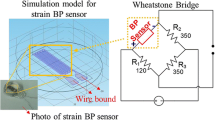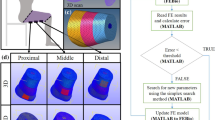Abstract
An inflatable cuff wrapped around the upper arm is widely used in noninvasive blood pressure measurement. However, the mechanical interaction between cuff and arm tissues, a factor that potentially affects the accuracy of noninvasive blood pressure measurement, remains rarely addressed. In the present study, finite element (FE) models were constructed to quantify intra-arm stresses generated by cuff compression, aiming to provide some theoretical evidence for identifying factors of importance for blood pressure measurement or explaining clinical observations. Obtained results showed that the simulated tissue stresses were highly sensitive to the distribution of cuff pressure on the arm surface and the contact condition between muscle and bone. In contrast, the magnitude of cuff pressure and small variations in elastic properties of arm soft tissues had little influence on the efficiency of pressure transmission in arm tissues. In particular, it was found that a thickened subcutaneous fat layer in obese subjects significantly reduced the effective pressure transmitted to the brachial artery, which may explain why blood pressure overestimation occurs more frequently in obese subjects in noninvasive blood pressure measurement.







Similar content being viewed by others
References
Franklin, S.S., Khan, S.A., Wong, N.D.: Is pulse pressure useful in predicting risk for coronary heart disease? The Framingham heart study. Circulation 100, 354–360 (1999)
Kannel, W.B., Gordon, T., Schwartz, M.J.: Systolic versus diastolic blood pressure and risk of coronary heart disease: the Framingham study. Am. J. Cardiol. 27, 335–346 (1971)
Riva-Rocci, S.: Un sfigmomanometro nuovo. Gaz. Med. Torino. 47, 981–996 (1896) (in Italian)
Korotkoff, N.S.: K voprosu o metodoach eesldovania krovyanovo davlenia. Imperatoor. Vorenno. JzV. Med. Akad. 11, 365–367 (1905) (in Russian)
Ohkubo, T., Imai, Y., Tsuji, I., et al.: Home blood pressure measurement has a stronger predictive power for mortality than does screening blood pressure measurement: a populationc-based observation in Ohasama, Japan. J. Hypertens. 16, 971–975 (1998)
Agarwal, R., Bills, J.E., Hecht, T.J.W., et al.: Role of home blood pressure monitoring in overcoming therapeutic inertia and improving hypertension control: a systematic review and meta-analysis. Hypertension 57, 29–38 (2011)
Cohn, J.N.: Blood pressure measurement in shock: mechanism of inaccuracy in auscultatory and palpatory methods. JAMA 199, 972–976 (1967)
Pickering, T.G., Hall, J.E., Appel, L.J., et al.: Recommendations for blood pressure measurement in humans and experimental animals; part 1: blood pressure measurement in humans: a statement for professionals from the Subcommittee of Professional and Public Education of the American Heart Association Council on High Blood Pressure Research. Hypertension 45, 142–161 (2005)
Sebo, P., Pechère-Bertschi, A., Herrmann, F.R., et al.: Blood pressure measurements are unreliable to diagnose hypertension in primary care. J. Hypertens. 32, 509–517 (2014)
Halm, M.A.: Arm circumference, shape, and length: how interplaying variables affect blood pressure measurement in obese persons. Am. J. Crit. Care 23, 166–170 (2014)
Liang, F.Y., Liu, H., Takagi, S.: The effects of brachial arterial stiffening on the accuracy of oscillometric blood pressure measurement: A computational model study. J. Biomech. Sci. Eng. 7, 15–30 (2012)
Ursino, M., Cristalli, C.: A mathematical study of some biomechanical factors affecting the oscillometric blood pressure measurement. IEEE Trans. Biomed. Eng. 43, 761–778 (1996)
Cristalli, C., Ursino, M.: Influence of arm soft tissue on non-invasive blood pressure measurements: an experimental and mathematical study. Measurement 14, 229–240 (1995)
Lan, H., Al-Jumaily, A.M., Lowe, A., et al.: Effect of tissue mechanical properties on cuff-based blood pressure measurements. Med. Eng. Phys. 33, 1287–1292 (2011)
Hargens, A.R., McClure, A.G., Skyhar, M.J., et al.: Local compression patterns beneath pneumatic tourniquets applied to arms and thighs of human cadavera. J. Orthop. Res. 5, 247–252 (1987)
Crenshaw, A.G., Hargens, A.R., Gershuni, D.H., et al.: Wide tourniquet cuffs more effective at lower inflation pressures. Acta. Orthop. 59, 447–451 (1988)
Palatini, P., Parati, G.: Blood pressure measurement in very obese patients: a challenging problem. J. Hypertens. 29, 425–429 (2011)
Ogden, R.W.: Non-Linear Elastic Deformations. Courier Corporation. Dover Publications, New York (1997)
Holzapfel, G.A.: Nonlinear Solid Mechanics: A Continuum Approach for Engineering. Wiley, Chichester (2000)
Dubuis, L., Avril, S., Debayle, J., et al.: Identification of the material parameters of soft tissues in the compressed leg. Comput. Method. Biomech. 15, 3–11 (2012)
Tang, C.Y., Zhang, G., Tsui, C.P.: A 3d skeletal muscle model coupled with active contraction of muscle fibres and hyperelastic behaviour. J. Biomech. 42, 865–872 (2009)
Ansari, M., Lee, S.K., Cho, C.D.: Hyperelastic muscle simulation. Key Eng. Mater. 345, 1241–1244 (2007)
Masson, I., Boutouyrie, P., Laurent, S., et al.: Characterization of arterial wall mechanical behavior and stresses from human clinical data. J. Biomech. 41, 2618–2627 (2008)
Calvo, B., Ramírez, A., Alonso, A., et al.: Passive nonlinear elastic behaviour of skeletal muscle: experimental results and model formulation. J. Biomech. 43, 318–325 (2010)
Hwang, W., Carvalho, J.C., Tarlovsky, I., et al.: Passive mechanics of canine internal abdominal muscles. J. Appl. Physiol. 98, 1829–1835 (2005)
Azar, F.S., Metaxas, D.N., Schnall, M.D.: Methods for modeling and predicting mechanical deformations of the breast under external perturbations. Med. Image. Anal. 6, 1–27 (2002)
Martin, R.B., Burr, D.B., Sharkey, N.A.: Skeletal Tissue Mechanics. Springer, New York (1998)
Bronner, F., Farach-Carson, M.C., Mikos, A.G.: Engineering of Functional Skeletal Tissues. Springer, New York (2007)
Pierin, A.M., Alavarce, D.C., Gusmao, J.L., et al.: Blood pressure measurement in obese patients: comparison between upper arm and forearm measurements. Blood Press. Monit. 9, 101–105 (2004)
Liang, F.Y., Takagi, S., Himeno, R., et al.: A computational model of the cardiovascular system coupled with an upper-arm oscillometric cuff and its application to studying the suprasystolic cuff oscillation wave, concerning its value in assessing arterial stiffness. Comput. Methods Biomech. Biomed. Eng. 16, 141–157 (2013)
Acknowledgments
The project was supported in part by the National Natural Science Foundation of China (Grant 81370438) and the SJTU Medical-Engineering Cross-cutting Research Project (Grant YG2015MS53). Zhipeng Deng was supported by the Hui-Chun Chin and Tsung-Dao Lee Chinese Undergraduate Research Program Endowment.
Author information
Authors and Affiliations
Corresponding author
Rights and permissions
About this article
Cite this article
Deng, Z., Liang, F. Numerical analysis of stress distribution in the upper arm tissues under an inflatable cuff: Implications for noninvasive blood pressure measurement. Acta Mech. Sin. 32, 959–969 (2016). https://doi.org/10.1007/s10409-016-0587-x
Received:
Revised:
Accepted:
Published:
Issue Date:
DOI: https://doi.org/10.1007/s10409-016-0587-x




